Ford F-Series
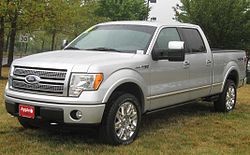 | |
| Manufacturer | Ford Motor Company |
|---|---|
| Production | 1948–present |
| Successor | Ford Super Duty (F-250, F-350, F-450, F-550, F-650, F-750) |
| Class | Full-size pickup truck |
| Layout | Front engine, rear-wheel drive /four-wheel drive |
The F-Series is a series of full-size pickup trucks from Ford Motor Company which has been sold continuously for over six decades. The most popular variant of the F-Series is the F-150. It was the best-selling vehicle in the United States for 24 years, currently the best-selling truck for 34 years, and the best selling vehicle in Canada, though this does not include combined sales of GM pickup trucks. In the tenth generation of the F-series, the F-250 and F-350 changed body style in 1998 and joined the Super Duty series.
During the post-World War II era, smaller Canadian rural communities had access to either a Ford dealer or a Lincoln-Mercury-Meteor dealer, but not both; a Mercury-badged version was sold at Lincoln-Mercury-Meteor dealers there from 1946-1968. Other than the grilles, trim, and badging, these trucks were identical to their Ford counterparts.
First generation (1948–1952)
The first F-Series truck (known as the Ford Bonus-Built) was introduced in 1948 as a replacement for the previous car-based pickup line introduced in 1941. The F-Series was sold in eight different weight ratings, with pickup, panel truck, cab-over engine (COE), conventional truck, and school bus chassis body styles.
Second generation (1953–1956)
The second generation trucks were given their now familiar names: The F-1 became the F-100, the F-2 became the F-250, and the F-3 became the 1-ton F-350.
Third generation (1957–1960)
For the third generation, Ford started its tradition of distinguishing the two types of pickup boxes; the traditional separate-fender body was called FlareSide, while a new smooth-sided look was known as StyleSide. The cabover F-Series was discontinued, having been replaced by the tilt-cab C-Series.
In 1959, Ford began in-house production of four-wheel drive trucks.
Fourth generation (1961–1966)
Ford introduced a new style of truck, unibody trucks, integrating the cab and the box; this was produced until 1963.
In 1965, the F-Series began to offer a 4-door crew cab as an option. Additionally that year, the Ranger name made its first appearance on a Ford truck; previously a base model of the Edsel, it was now used to denote a high-level styling package for F-Series pickups. A new chassis also marked the first appearance of Twin I-Beam front suspension.
Fifth generation (1967–1972)
In 1967, along with a minor update, the F-Series changed the Ranger from an option package to a separate trim level. In response to federal regulations, Ford added a number of exterior lights in 1968 and made some changes to the interior controls.
Sixth generation (1973–1979)
The changes for the sixth generation were largely cosmetic; Ford made several year-to-year changes, with significant grill redesign at 1977 1/2 and rectangular headlights being introduced for 1978 models. More substantial introductions included the addition of front disc brakes. On four-wheel drive models, the front suspension was now equipped with coil springs on the half-ton models. To increase passenger room, the cab was lengthened three inches. For those wanting a rear passenger seat in a smaller truck than a crew cab, the SuperCab was introduced in 1974.
In 1975, the F-150 was introduced in between the F-100 and the F-250; eventually, it would replace the former as the standard F-Series model. For 1978, the Bronco was redesigned; much like the contemporary Chevrolet Blazer, it was now a shortened version of the four-wheel drive F-Series.
Seventh generation (1980–1986)
The 1980 F-Series was redesigned with an all-new chassis and larger body; this was the first ground-up redesign since 1965. While similar to the previous generation, the exterior of the trucks was redone to improve aerodynamics and fuel economy. Medium-duty F-Series (F-600 and above) were also redesigned; although they shared the cab of the smaller pickup trucks, the largest version of F-Series now wore a front hood with separate front fenders (like the L-Series).
In a move towards fuel effiency, the F-Series gained smaller Windsor V8 engines from the Panther platform. In 1983, Ford added diesel power to the F-Series through a partnership with International Harvester (later Navistar). The 6.9L V8 produced similar power output as the gasoline Ford 351 V8, with the fuel economy of the 300 I6.
A noticeable change was made to the F-Series in 1982 as the Ford "Blue Oval" was added to the center of the grille. It would mark the final year of the Ranger trim; the name had been shifted onto the all-new compact pickup developed as a replacement for the Courier. It also marked the final year for the F-100, which had largely been superseded by the F-150.
Eighth generation (1987-1991)
An upgrade of the 1980 platform, the eighth-generation F-Series saw aerodynamic changes to the front clip to improve fuel efficiency. The styling was simplified; composite headlights were separated from the grille. For the first time, the front bumper was integrated into the bodywork instead of being an add-on part. Crew-cab models now had full-width windows in their rear doors. Under the hood, fuel injection (introduced in 1986) replaced carbureted engines completely by 1988.
After many years of losing sales to the StyleSide version, Ford quietly dropped the FlareSide bed as an option. To bridge the gap between the F-350 and the medium-duty F-600, the F-Super Duty was introduced in 1987. The Super Duty was fitted with a suspension that allowed for a higher GVWR; it also came with only the 7.5L V8 or the 7.3L diesel V8. Intended for commercial use, it was available only as a chassis-cab model.
Ninth generation (1992–1996)
The 1980 F-Series underwent a major cosmetic update for the 1992 model year; again, many of the exterior updates focused on increasing its aerodynamics. The update also brought the F-Series in line with the Ranger and Explorer stylistically. SuperCab models of this generation are distinguished by single (instead of twin) side windows for the rear seat. In 1994, an update added an airbag to the F-Series to the first time. The same year, the medium-duty trucks received their first exterior update since 1980; this integrated the turn signals and grille.
Dormant since 1987, the FlareSide bed returned for 1992. Instead of the traditional pickup bed seen before, the new FlareSide borrowed much of its rear bodywork from the dual rear-wheel F-350. For 1993, Ford introduced the SVT Lightning; powered by a modified 5.8L V8 and including modifications to the suspension, the Lightning was sold through 1995.
Tenth generation (1997–2004)
Introduced early in 1996, the 1997 F-150 was redesigned from the ground up for the first time since 1980. Rounded styling allowed for improved aerodynamics, a larger interior, and improved fuel economy. Sharing a V6 engine with the Taurus/Windstar and its V8 engine with the Crown Victoria, the F-150 received an all-new engine lineup. To improve rear-seat access, a third door was added to SuperCab models; in 1999, SuperCabs became four-doors. For 2001, the SuperCrew crew cab was added; it combined the larger seat of a crew cab with a slightly shortened rear cargo bed.
This generation of the F-Series marked the split of the F-150 from heavier-duty trucks. In 1999, after a two-year hiatus, the F-350 was reintroduced as the Super Duty; the Super Duty model included the F-250 through the F-550 (the latter being a chassis-cab model). In a joint venture with International, Ford redesigned the medium-duty F-Series, now part of the Super Duty lineup; the B-Series bus chassis was discontinued.
For 2001 and 2002, this version of the F-150 was sold by Lincoln-Mercury dealers as the Lincoln Blackwood. The first Lincoln pickup truck, the Blackwood was an F-150 SuperCrew with Lincoln Navigator front bodywork and interior; the bed was covered by a powered tonneau.
Eleventh generation (2004–2008)
For the 2004 model year, the F-150 was redesigned on an all-new platform. Externally similar to its predecessor, the eleventh-generation wore sharper-edged styling; a major change was the adoption of the stepped driver's window from the Super Duty trucks. Regardless of cab type, all F-150s were given 4 doors.
In 2008, the Super Duty trucks were also given an an all-new platform. While using the same bed and cab as before, these are distinguished from their predecessors by an all-new interior and a much larger grille and headlights. Previously available only as a chassis-cab model, the F-450 now was available as a pickup truck directly from Ford.
From 2005 to 2008, this version of the F-150 was sold as the Lincoln Mark LT.
Twelfth generation (2009–present)
The current-generation F-150 was introduced for the 2009 model year as a major update of the Ford full-size truck platform. These trucks are distinguished by their Super Duty-style grilles and headlights; standard cab models again have two doors instead of four. The FlareSide bed was dropped along with the manual transmission; outside of Mexico, the Lincoln Mark LT was replaced by the F-150 Platinum. A new model for 2010 included the SVT Raptor, a dedicated off-road truck.
As part of a major focus on fuel economy, the entire engine lineup for the F-150 (excluding the SVT Raptor) was updated for the 2011 model year. Along with two new V8 engines, the F-150 gained a twin-turbocharged 3.5L V6, dubbed EcoBoost by Ford. Other modifications include the addition of electric-assisted power steering on most models. This EPAS is an advanced system which increases efficiency and driver control.
For 2011, the Super Duty trucks received a major redesign; for the first time, the PowerStroke diesel V8 is a Ford-designed engine. This generation is distinguished by a 2-bar grille (instead of the traditional three) and a clamshell hood. As with the F-150, the manual transmission was dropped from the Super Duty; V10 engines are no longer available in pickup-truck models.
Special models
SVT Lightning
The SVT Lightning is a sports/performance version of the F-150, released by Ford's Special Vehicle Team (SVT) division. Introduced for the 1993 model year, the SVT Lightning competed against the Chevrolet 454 SS, primarily as an effort to enhance the sporty, personal-use image of the Ford F-Series pickup. Powered by a 240 hp 5.8 L V8, the Lightning shared its basic structure with the F-150, but many modifications were made to the suspension and the frame to improve the handling. Production was 11,563 SVT Lightnings between the 1993 and 1995 model years.
In 1999, after a three-year hiatus, Ford SVT unveiled a new Ford Lightning. Much like its predecessor, it was based on the F-150 with substantial suspension modifications. Although the Lightning shared its 5.4 L V8 with the standard F-150, it now used a supercharger, producing 360 hp (380 after 2001). To handle the extra power, the 4-speed automatic transmission was borrowed from Ford's V10/diesel Super Duty trucks. SVT Lightnings produced between 1999 and 2004 numbered 28,124, when it was discontinued. This edition is featured in the videogame Gran Turismo 5.
Harley Davidson Edition
In 2000, Ford released the first Harley Davidson Edition F-150; it was available in a SuperCab with a standard-length bed. For 2001, the Harley-Davidson Edition was moved to the Supercrew F-150. In 2002, Ford opted to further specialize the Harley Davidson Edition by adding the supercharged motor from the SVT Lightning, with a slightly larger pulley to reduce boost by 2 lbs. To coincide with Harley-Davidson's centenary, the 2003 edition added the requisite 100th Anniversary badging; these were available on Supercrew F-150s with the supercharged 5.4 liter V-8
For the 2004-2009 F-150, the Harley-Davidson Edition became mainly an appearance package; its availability was expanded to the F-250 and F-350 Super Duty series.
On February 10, 2009 at the Chicago Auto Show, the latest version of the Harley-Davidson F-150 was introduced. Adopting many luxury features of the Platinum Edition, this Harley went one step further by providing leather seating surfaces derived from authentic Harley biker-jacket materials, as well as the requisite exhaust tones and power to reach a top speed of 115 miles per hour (185 km/h).
SVT Raptor
For the 2010 model year, Ford introduced the SVT Raptor model of the F-150. Intended for dedicated off-road use, the Raptor has a number of modifications to improve its off-road ability. It includes a full set of FOX shocks with 11.2" of front suspension travel and 12.1" of rear travel. It wears a wider body and fenders than the standard F-Series truck. In a departure from the F-150, or any other Ford vehicle, the Raptor wears no blue-oval Ford emblem on its grille (for the first time since 1982); instead, the grille has "F-O-R-D" spelled out in the center. In 2011, a full four-door SuperCrew model was added to the standard 2+2 door SuperCab model.
The Raptor is powered by a 411 hp 6.2 L V8 (shared with the Ford Super Duty); it is paired with a 6-speed automatic transmission.
F-150 Platinum
Ford ceased sales of the Lincoln Mark LT in the United States and Canada after the 2008 model year.In its place beginning in the 2009 model year, Ford created an upper-end trim of the 2009 F-150 called F-150 Platinum. Due to its continuing popularity there, the Platinum is rebadged as the Lincoln Mark LT in Mexico.
Motorsports
In 2008, Ford announced its entrance into the Baja 1000 class eight race for moderately modified, full-size pickup trucks. The driver of record was Steve Oligos, supported by codrivers Randy Merritt, Greg Foutz, and Bud Brutsman. The vehicle was built with collaboration between the Ford Special Vehicle Team (SVT), Ford Racing, and Foutz Motorsports, Inc. The Ford F-150 SVT Raptor R completed the 2008 41st Tecate SCORE Baja 1000 race in 25:28:10, and ranked third in its class.
In the Best In The Desert race series, an F150 SVT Raptor R completed the "Terrible's 250" race, placing second overall in the Class 8000.
In January 2010, a single Raptor SVT (#439), driven by Chilean driver Javier Campillay, competed in the Argentina-Chile Dakar Rally. However, the truck was unable to finish due a catch-up crash with another car in the middle of a road during stage seven. In January 2011, two Raptors started in the Argentina-Chine Dakar Rally in Buenos Aires, with Campillay driving the more reliable Raptor (#375), and American female driver Sue Mead driving a T2 Raptor (#374). Mead crossed the finish line in Buenos Aires and won the "Super Production" class, the first North American class win in Dakar history. Campillay was unable to finish the 12th stage after losing time due to mechanical failure during the 11th stage, which led to his disqualification for failing to reach the race camp by the designated deadline.
Awards and recognition
The Ford F-150 has won numerous awards; in 2009 alone, it received:
- Motor Trend 2009 Truck of the Year Award
- 2009 Best Redesigned Vehicle from Kelley Blue Book’s kbb.com
- Top honors as "Truck of Texas" as well as "Best Luxury Pickup" for the 2009 F-150 King Ranch from Texas Auto Writers Association
- "Best Overall Half-Ton Pickup" from PickupTrucks.com
- "Automotive Excellence" award in the Workhorse Category from Popular Mechanics
- "Top Safety Pick" from the Insurance Institute for Highway Safety for its standard safety technology: Safety Canopy side curtain air bags and AdvanceTrac with Roll Stability Control
- "Residual Value" award from Automotive Leasing Guide (ALG) for retaining the highest percentage of its original price among 2009 full-size light-duty pickups at the end of a conventional three-year lease, based on ALG projections
- Motor Trend's Truck Trend Top 5 Trucks from Specialty Equipment Market Association (SEMA) for 2009 Ford F-150 Heavy Duty DeWalt Contractor Concept
- "Accessory-Friendly Truck" Design Award from SEMA
Sales
| Calendar Year | United States | Canada | Total |
|---|---|---|---|
| 1999 | 869,001 | ||
| 2000 | 876,716 | ||
| 2001 | 911,597 | ||
| 2002 | 813,701 | ||
| 2003 | 845,586 | ||
| 2004 | 939,511 | ||
| 2005 | 901,463 | ||
| 2006 | 796,039 | ||
| 2007 | 690,589 | ||
| 2008 | 515,513 | ||
| 2009 | 413,625 | ||
| 2010 | 528,349 | 97,913 | 626,262 |
| 2011 | 584,917 |
Notes
- Ford also manufactures F-Series medium and heavy-duty trucks alongside the F-150, F-250, and F-350s (F-450, F-550, F-650, F-750). School bus chassis versions were sold asB-Series trucks until 1998. The 1961–1965 Ford Falcon Econoline flat nose pickup trucks and 1961–present vans are E-Series. Parcel delivery vans are P-Series. Big tractor-trailer trucks are L-Series. There was also a class 8 cab-over called the W-Series in the 60s-70s, replaced by the CL-Series in 1977.
- In Argentina and Brazil, the gasoline engines are often converted to also run with alternative fuels, E-96h (Brazilian-spec ethanol) and compressed natural gas (CNG). Biodiesel also is used in diesel engines.
- Ford also builds right-hand drive versions of the F-Series in Brazil for export to countries that drive on the left side of the road, such as the United Kingdom and Australia.
- Prior to the F-650 and F-750 medium-duty trucks, Ford offered F-700, F-800 and F-900 medium-duty trucks that retained the door and aft cab (A-pillar back) style and structure from the previous generation F-Series, along with the dash and instrument cluster (from early 1980s models). Current models are based on the International 4000 Series chassis with a Ford Super Duty cab.
- An F-8000 was also produced based on the Ford Cargo cab-over range, which was similar to the 2006 and newer Ford LCF ("Low Cab Forward").
- In Mexico, the 1997–2004 style F-150 is still built and sold, with the F-150 having a 4.2L V6 and the F-250 (with the same styling, interior, etc.) having a 4.6L V8. The US-market F-150 is sold as the Ford Lobo.
- Though it was unpopular in the US, the Lincoln Mark LT (an upscale version of the US-market F-150) made up 40% of Lincoln sales in Mexico. Consequently, the Mark LT continues to be sold in Mexico, with the latest model a Lincoln-badged F-150 Platinum

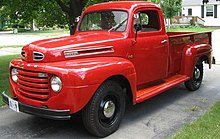
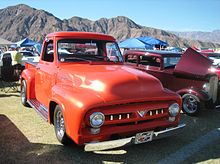

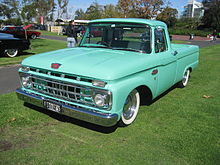










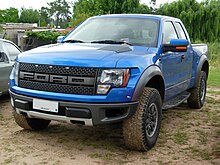

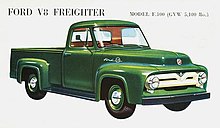


![Validate my RSS feed [Valid RSS]](valid-rss-rogers.png)















































































ไม่มีความคิดเห็น:
แสดงความคิดเห็น